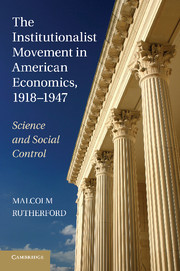Book contents
- Frontmatter
- Contents
- List of Tables
- Acknowledgments
- PART ONE INTRODUCTION
- PART TWO INSTITUTIONALIST CAREERS
- PART THREE CENTERS OF INSTITUTIONAL ECONOMICS
- PART FOUR CHALLENGES AND CHANGES
- 10 The Institutionalist Reaction to Keynesian Economics
- 11 Neoclassical Challenges and Institutionalist Responses
- PART FIVE CONCLUSION
- Archive Collections Consulted
- References
- Index
- Titles in the series
11 - Neoclassical Challenges and Institutionalist Responses
Published online by Cambridge University Press: 03 May 2011
- Frontmatter
- Contents
- List of Tables
- Acknowledgments
- PART ONE INTRODUCTION
- PART TWO INSTITUTIONALIST CAREERS
- PART THREE CENTERS OF INSTITUTIONAL ECONOMICS
- PART FOUR CHALLENGES AND CHANGES
- 10 The Institutionalist Reaction to Keynesian Economics
- 11 Neoclassical Challenges and Institutionalist Responses
- PART FIVE CONCLUSION
- Archive Collections Consulted
- References
- Index
- Titles in the series
Summary
When institutional economics first emerged, the state of neoclassical economics was pretty much as J. B. Clark and Alfred Marshall had left it in the 1890s. The theory of the consumer was based on cardinal utility and, for most purposes, assumed given preferences and a constant marginal utility of money. The theory of markets dealt only with perfect competition or with pure monopoly. The theory of labor markets and of distribution also assumed competitive conditions. Marshall's discussion of externalities only applied to external costs or benefits external to firms but internal to industries, and was largely taxonomic in effect. It was easy to question the applicability of this body of theory to a dynamic economic world of corporations, consolidations and mergers, salesmanship, trade unions, labor unrest, business depressions, and so on. Even among the more orthodox American economists themselves, it was rarely claimed that the standard theory provided anything more than a first approximation to a much more complex and dynamic world. Neoclassical economics could claim a consistent body of theory, but the applicability, predictive power, policy usefulness, and empirical testability of that theory were frequently questioned, and not only by institutionalists.
In 1932, Paul Homan launched a major criticism of the progress of institutionalist program since its formation in 1918. Homan was, of course, a knowledgeable critic, having been a student at Brookings. Homan's argument was based on a particular definition of the aims of the institutionalist movement.
- Type
- Chapter
- Information
- The Institutionalist Movement in American Economics, 1918–1947Science and Social Control, pp. 309 - 342Publisher: Cambridge University PressPrint publication year: 2011

